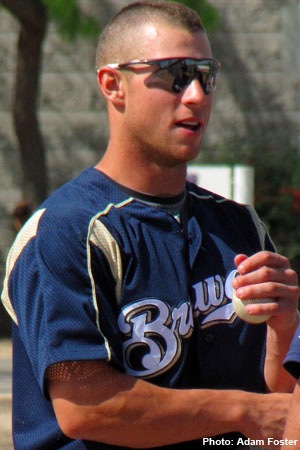
You hit on some guys and you miss on others. Watching Brett Lawrie crush a fastball over the center-field wall last month served as a loud reminder of what's shaping up to be one of my biggest misses.
In 2011, I took a vocal stance against Lawrie and his odds of turning into an impact big leaguer. Now that I've discussed each item at length with scouts since, allow me to open the doors into my learning process. My logic (published here) didn't put enough weight into three scouting essentials, which are detailed below:
1. Age, age, age
It has always been one of my favorite addictions in baseball. And most people share it.
Who doesn't want to see someone who should be overmatched find success at the highest level? And what disadvantage is greater than lack of experience? What of the potential for future physical growth?
I've created some algorithms that identify young minor leaguers who are performing at impressive levels, relative to their peers. They contextualize performances that may seem pedestrian through a traditional lens.
My hope is that they will allow me to whittle down thousands of minor league names into lists that contains the bulk of the big league's future stars (who have played full-season ball). Lawrie would have been on this list.
My goal with this exercise hasn't been to create a perfect system with which to never miss on a prospect again. That's not realistic. My goal as been to make sure that I'm focusing on a high-upside group of talents. To give this group extra attention.
Age is the most important variable in identifying high-upside talent. It is context and it is projection. It is extremely important.
2. Bat speed!
Gary Sheffield is one of my favorite examples of bat speed. With his bat waggle, he said: I have more bat speed than almost any mortal and I'm going to tease you with it.
Hitting mechanics do mean something and can be the success or final blow for a hitter. But elite bat speed may not be bothered by irregular mechanics.
I questioned Lawrie's crouch and his ability to hit breaking balls while stepping up his power game. I saw an aggressive hitter who some pitchers may be able to decode. I should have fixed my gaze a little more closely the raw gifts of the young, upper-minors hitter I was evaluating. Lawrie showed no-doubt elite bat speed in the minors.
3. Patience/Approach
A hitter's patience at the plate is one of the biggest areas I've changed my opinion on over the last year.
Seeing Derek Norris and Jaff Decker patiently wait on pitches to float into their happy zones last fall started my change. Both hitters have drawn a lot of walks, but they've also selected pitches to attack over identifying pitches and adjusting. This has resulted in both falling behind in the count and plays a big role in their high strikeout rates -- note that Norris has made some adjustments this season.
Seeing Mike Trout and Wil Myers, I observed hitters who identify pitches early and utilize elite bat speed to stay back and drive the ball. Both balance patience with the ability to hit fastballs and off-speed pitches with authority. It's a lethal combination.
Next, I took things a step further. I studied two of the best hitters in the big leagues who also don't consistently draw a lot of walks: Ryan Braun and Troy Tulowitzki. Seeing them succeed while offering at more than just "their pitch" taught me two lessons:
a. A hitter who doesn't draw a lot of walks can still be one of the best hitters in baseball.
b. Pitch recognition is more important than patience.
Pablo Sandoval and Vladimir Guerrero are two extreme examples of this -- I'm talking Guerrero in his prime here. Both routinely swing at pitches that are no where near the zone. But both also identify/identified pitches well enough to utilize their bat speed and barrel control to make hard, regular contact.
The keys to hitting are balance and bat speed. Some hitters have more balance when they connect than others. But the truly elite hitters are the ones who can put themselves in position to allow the ball to shoot of their bats in a variety of scenarios.
Lawrie is an aggressive hitter. But I wouldn't change a thing about his approach. He hits the ball hard consistently and projects as a well-above-average MLB hitter in his prime.
Conclusion
It may sound preposterous but even pro scouts aren't always right. Many of the scouts I've discussed Lawrie with have told me about their big misses. Players mentioned included stars and superstars.
Baseball is a humbling game on a number of wavelengths. It's unpredictability is the greatest gift (and challenge) that it offers.
A well-studied mind learns from the paths of others dabbling in his field. We are fortunate be present in a time where information is readily available to further our own thinking.
I know a certain percentage of the Internet will know me as the guy who swung-and-missed on Lawrie. I also know a percentage of the Internet will know me as the guy who, like everyone, isn't always right but also isn't afraid to confront his mistakes and learn from them.

